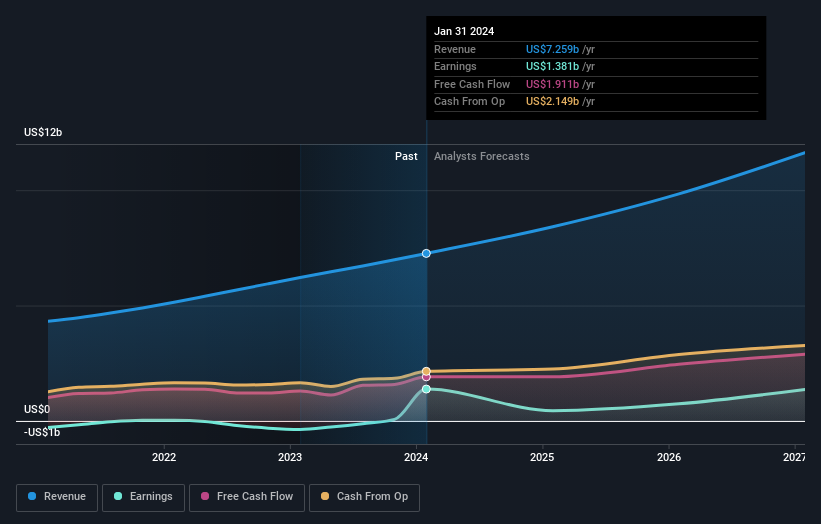Workday, Inc. Just Beat Earnings Expectations: Here's What Analysts Think Will Happen Next
The yearly results for Workday, Inc. (NASDAQ:WDAY) were released last week, making it a good time to revisit its performance. It looks like a credible result overall - although revenues of US$7.3b were what the analysts expected, Workday surprised by delivering a (statutory) profit of US$5.21 per share, an impressive 450% above what was forecast. This is an important time for investors, as they can track a company's performance in its report, look at what experts are forecasting for next year, and see if there has been any change to expectations for the business. With this in mind, we've gathered the latest statutory forecasts to see what the analysts are expecting for next year.
View our latest analysis for Workday
Taking into account the latest results, the most recent consensus for Workday from 36 analysts is for revenues of US$8.41b in 2025. If met, it would imply a solid 16% increase on its revenue over the past 12 months. Statutory earnings per share are expected to tumble 68% to US$1.68 in the same period. In the lead-up to this report, the analysts had been modelling revenues of US$8.45b and earnings per share (EPS) of US$1.77 in 2025. The analysts seem to have become a little more negative on the business after the latest results, given the small dip in their earnings per share numbers for next year.
Althoughthe analysts have revised their earnings forecasts for next year, they've also lifted the consensus price target 6.8% to US$311, suggesting the revised estimates are not indicative of a weaker long-term future for the business. The consensus price target is just an average of individual analyst targets, so - it could be handy to see how wide the range of underlying estimates is. Currently, the most bullish analyst values Workday at US$350 per share, while the most bearish prices it at US$190. There are definitely some different views on the stock, but the range of estimates is not wide enough as to imply that the situation is unforecastable, in our view.
One way to get more context on these forecasts is to look at how they compare to both past performance, and how other companies in the same industry are performing. The period to the end of 2025 brings more of the same, according to the analysts, with revenue forecast to display 16% growth on an annualised basis. That is in line with its 18% annual growth over the past five years. Compare this with the broader industry, which analyst estimates (in aggregate) suggest will see revenues grow 12% annually. So although Workday is expected to maintain its revenue growth rate, it's definitely expected to grow faster than the wider industry.
The Bottom Line
The most important thing to take away is that the analysts downgraded their earnings per share estimates, showing that there has been a clear decline in sentiment following these results. Fortunately, they also reconfirmed their revenue numbers, suggesting that it's tracking in line with expectations. Additionally, our data suggests that revenue is expected to grow faster than the wider industry. We note an upgrade to the price target, suggesting that the analysts believes the intrinsic value of the business is likely to improve over time.
Following on from that line of thought, we think that the long-term prospects of the business are much more relevant than next year's earnings. At Simply Wall St, we have a full range of analyst estimates for Workday going out to 2027, and you can see them free on our platform here..
That said, it's still necessary to consider the ever-present spectre of investment risk. We've identified 1 warning sign with Workday , and understanding this should be part of your investment process.
Have feedback on this article? Concerned about the content? Get in touch with us directly. Alternatively, email editorial-team (at) simplywallst.com.
This article by Simply Wall St is general in nature. We provide commentary based on historical data and analyst forecasts only using an unbiased methodology and our articles are not intended to be financial advice. It does not constitute a recommendation to buy or sell any stock, and does not take account of your objectives, or your financial situation. We aim to bring you long-term focused analysis driven by fundamental data. Note that our analysis may not factor in the latest price-sensitive company announcements or qualitative material. Simply Wall St has no position in any stocks mentioned.

